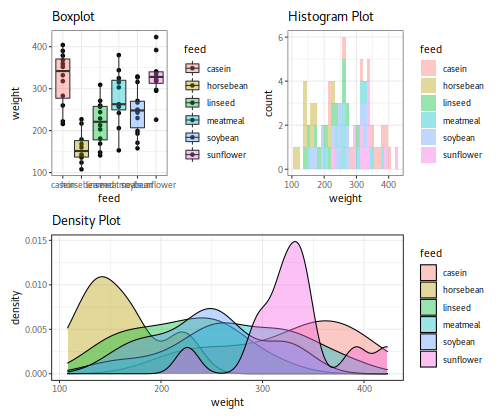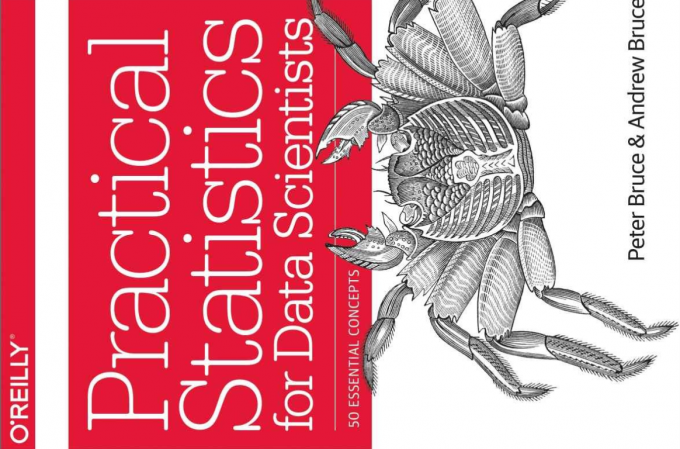Statistic for Data Scientists 1| | Reading Notes
Estimates of Location
Mean; Weighter mean, Median, Weighted median, Trimmed mean, Robust, Outlier.
| Mean | $\overline{x} = \frac{\sum_ i^ n x_ i}{n}$ |
| Trimmed mean | $ \overline{x} = \frac{\sum_ {i=p+1} ^{n-p} x_ {(i)}}{n-2p}$ |
| Weighted mean | $\overline{x}_ w = \frac{\sum_ {i=1} ^ n w_ i x_ i}{\sum_ i ^ n w_ i }$ |
Estimates of Variability
| Term | Synonyms | Description |
|---|---|---|
| Deviations | errors, residuals | The difference between the observed values and the estimate of location |
| Varuance | mean-squared-error | THe sum of squared deviations from the mean divided by $n - 1$ where n is the number of data values |
| Standard deviation | l2-norm, Eucliden norm | The square root of the variance. |
| Mean absolute deviation | l1-norm, Manhattan norm | The mean of the absolute value of the deviations from the mean. |
| Median absolute deviation from the median | The median of the absolute value of the deviations from the median | |
| Range | The difference between the largest and the smallest value in a data set. | |
| Order statistics | Ranks | Metrics based on the date values sorted from smallest to biggest. |
| Precentile | quantile | The value such that P percent of the values take on this value or less ad (100-P) percent take on this value or more. |
| Interquartile range | IQR | The differentce between the 75th percentile and the 25th percentile. |
Deviation
| Mean absolution deviation | $\frac{\sum ^ n _ {i=1} | x_ i - \overline{x}|}{n}$ |
| Variance | $s^ 2 = \frac{\sum (x - \overline{x})^ 2}{n-1}$ |
| Standard deviation | $s = \sqrt{s^ 2}$ |
For Mean absolution deviation:
|
For Variance:
|
For Standard Deviation
|
Why n - 1
In the intuitive denominator of n in the variance formulation, it would underestimate the true variance and the standard deviation. This is referred to as a biased estimate.
If you divided by $n-1$, the standard deviation becomes an unbiased estimate.
Test: function SD() and sd()
SD() is using $n$, which is biased estimate,
sd() is the base function of R, which use unbiased estimate.
|
|
| List | SD | sd | mad | var |
|---|---|---|---|---|
| $c(1,2,3,4,5,6,7,8,9,10)^ {1}$ | 2.87228132326901 | 3.02765035409749 | 3.7065 | 9.16666666666667 |
| $c(1,2,3,4,5,6,7,8,9,10)^ {1.1}$ | 3.71464847156818 | 3.91558329233956 | 4.81903250216669 | 15.3317925192487 |
| $c(1,2,3,4,5,6,7,8,9,10)^ {1.2}$ | 4.77822834483576 | 5.03669491668582 | 6.21842448942231 | 25.3682956837688 |
| $c(1,2,3,4,5,6,7,8,9,10)^ {1.3}$ | 6.1203589266995 | 6.45142476870465 | 7.97443123015422 | 41.6208815462559 |
| $c(1,2,3,4,5,6,7,8,9,10)^ {1.4}$ | 7.81312940963156 | 8.23576152936081 | 10.1733320771185 | 67.8277679684995 |
| $c(1,2,3,4,5,6,7,8,9,10)^ {1.5}$ | 9.94716631430172 | 10.4852339392319 | 12.9217964296424 | 109.940130760421 |
| $c(1,2,3,4,5,6,7,8,9,10)^ {1.6}$ | 12.6363910464884 | 13.3199257038206 | 16.2215684620237 | 177.420420755302 |
| $c(1,2,3,4,5,6,7,8,9,10)^ {1.7}$ | 16.0239981545644 | 16.8907771302528 | 19.8184284109695 | 285.298352063871 |
| $c(1,2,3,4,5,6,7,8,9,10)^ {1.8}$ | 20.289967545938 | 21.3875036986871 | 24.1444312624589 | 457.425314461353 |
| $c(1,2,3,4,5,6,7,8,9,10)^ {1.9}$ | 25.6605043589986 | 27.0485465610381 | 29.3423269903854 | 731.623871064649 |
| $c(1,2,3,4,5,6,7,8,9,10)^ {2}$ | 32.4199012953463 | 34.1735765370459 | 35.5824 | 1167.83333333333 |
(Click the tag “var” below to dismiss the line “var”)
Percentile
Percentile was widely used in boxplot (interquartile range or IQR). It was more sensitive to the outliers, and the massive calculation also restricted its applicability since it needs sorting the data set though there are a machine learning algorithms to get an approximate percentile very quickly[1].
When the data (n is even):
$$
100 \frac{j}{n} \le P < 100\frac{j+1}{n}
$$
Formally, the percentile is the weighted average:
$$
P = (1 - w) x _ {(j)} + wx_ {j + 1}
$$
IQR in R:
$$
IQR(x) = quantile(x, 3/4) - quantile(x, 1/4)
$$
|
[1] 4.5
Variation illustration
|
 |
|---|
| @ Karobben |
Statistic for Data Scientists 1| | Reading Notes
https://karobben.github.io/2021/04/13/LearnNotes/statistics-ds-1/








